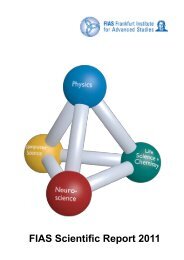FIAS Scientific Report 2010 - Frankfurt Institute for Advanced Studies ...
FIAS Scientific Report 2010 - Frankfurt Institute for Advanced Studies ...
FIAS Scientific Report 2010 - Frankfurt Institute for Advanced Studies ...
You also want an ePaper? Increase the reach of your titles
YUMPU automatically turns print PDFs into web optimized ePapers that Google loves.
Lattice QCD calculation of Taylor expansion coefficients with respect to chemical potential<br />
Collaborators: O. Kaczmarek 1 , F. Karsch 1,2,3 , E. Laermann 1 , C. Miao 2 , S. Mukherjee 2 , P. Petreczky 2<br />
C. Schmidt 3,4 , W. Söldner 3,4 , W. Unger 3,4<br />
1 Universität Bielefeld, Bielefeld, Germany, 2 BNL, Upton, NY, USA, 3 GSI, Darmstadt, Germany, 4 <strong>FIAS</strong>, <strong>Frankfurt</strong> am<br />
Main, Germany.<br />
Lattice QCD calculations at nonzero chemical potential by means of standard Monte Carlo methods are impossible<br />
due to the notorious sign problem. In order to extent first principle lattice QCD calculations to small but<br />
nonzero chemical potentials and circumvent the sign problem, we per<strong>for</strong>m a calculation of Taylor expansion<br />
coefficients of the pressure and the chiral condensate (chiral order parameter). Numerical calculations have<br />
been per<strong>for</strong>med with an improved staggered fermion action (p4) <strong>for</strong> (2+1)-flavor QCD. The heavier strange<br />
quark mass is kept close to its physical value, while the degenerate light quark masses are decreased towards<br />
the massless limit.<br />
The Taylor expansion coefficients of the pressure (as shown in the left plot) are of direct interest to the phenomenology<br />
of heavy ion collisions, as they are directly connected to moments of the fluctuation of conserved<br />
charges such as baryon number, electric charge and strangeness. Of great interest are also ratios of these moments,<br />
such as e.g. the kurtosis. Here the dependence on the interaction volume as well as on the mass spectrum<br />
of the theory is completely suppressed. The leading order dependence of the kurtosis on the baryon chemical<br />
potential along the freeze-out curve as a function of the center of mass energy is shown in the right plot.<br />
1<br />
0.1<br />
χ B 2<br />
χ B 4<br />
χ B<br />
6<br />
T/Tc μB /T0 0.01<br />
0.6<br />
0.8 0.85 0.9 0.95 1 1.05 1.1 0 0.5 1 1.5 2 2.5 3 3.5 4<br />
1.2<br />
1.1<br />
1<br />
0.9<br />
0.8<br />
0.7<br />
T/T 0<br />
m = 0<br />
m = ∞<br />
6<br />
5<br />
4<br />
3<br />
2<br />
1<br />
0<br />
χ 4 B /χ2 B<br />
O(μ 0 )<br />
O(μ 2 )<br />
HRG<br />
10 100<br />
s 1/2 [GeV]<br />
Moments of the baryon number fluctuations (left), phase boundary in the chiral limit and freeze-out<br />
line (middle) and ratio of baryon number fluctuations (kurtosis) along the freeze-out curve (right).<br />
The Taylor expansion coefficients of the chiral condensate provide access to the critical behavior of QCD.<br />
By matching the order parameter and its (mixed) susceptibilities to corresponding scaling functions we obtain<br />
the scaling fields. The mixing of the reduced temperature and the chemical potential yields the curvature<br />
of the critical line in the chiral limit as show in the middle plot. As a result we obtain Tc(μB)/Tc(0) = 1 −<br />
0.0066(7)(μB/T) 2 + O((μB/T) 4 ). We thus find that the curvature of the critical line is about a factor of 3-4<br />
smaller than the experimentally obtained freeze-out curve (also shown in the middle plot).<br />
This work has been supported in parts by contracts DE-AC02-98CH10886 with the U.S. Department of Energy,<br />
the BMBF under grant 06BI401, the Gesellschaft für Schwerionen<strong>for</strong>schung under grant BILAER, the Extreme<br />
Matter <strong>Institute</strong> under grant HA216/EMMI and the Deutsche Forschungsgemeinschaft under grant GRK 881.<br />
Related publications in <strong>2010</strong>:<br />
1) F. Karsch, E. Laermann, C. Miao, S. Mukherjee, P. Petreczky, C. Schmidt, W. Soeldner, W. Unger, to be<br />
published in Phys. Rev. D; [arXiv:1011.3130[hep-lat]].<br />
2) M. Cheng, et al. [RBC-Bielefeld Collaboration]; arXiv:1010.1216 [hep-lat].<br />
3) C. Schmidt, arXiv:1012.2230[hep-lat].<br />
4) C. Schmidt and S. Mukherjee, PoS (Lattice <strong>2010</strong>) 214; [arXiv:1012.2231[hep-lat]].<br />
5) C. Schmidt, Prog. Theor. Phys. Supplement No. 186 (<strong>2010</strong>) 563; [arXiv:1007.5164 [hep-lat]].<br />
46

















